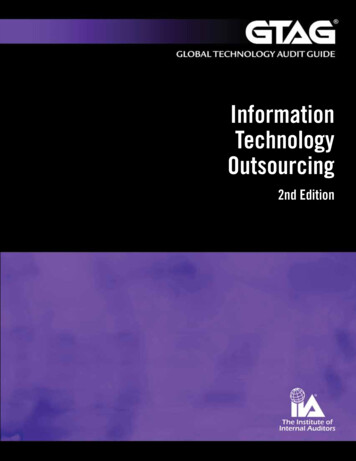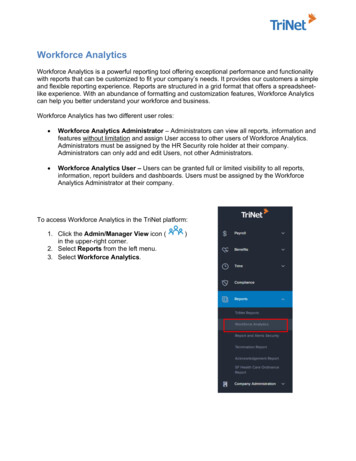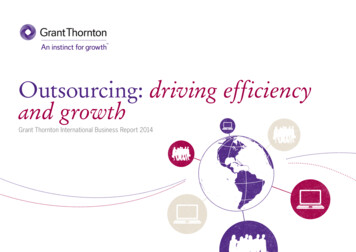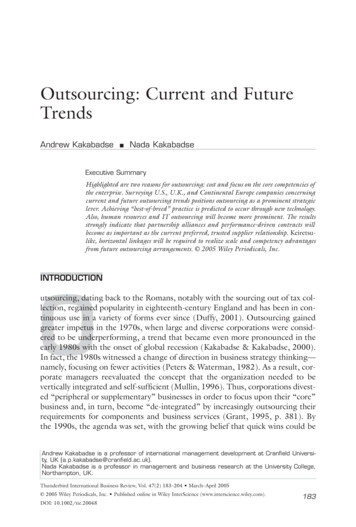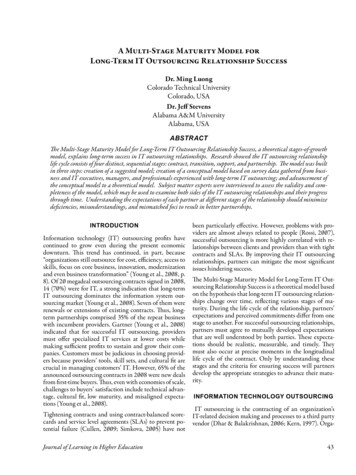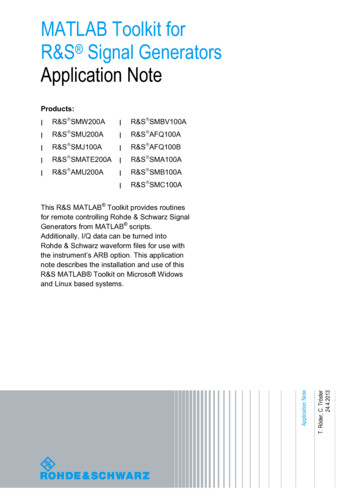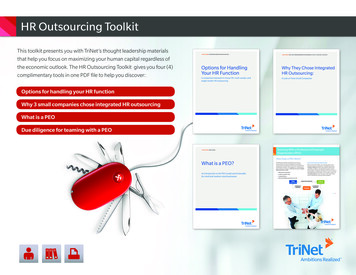
Transcription
HR Outsourcing ToolkitThis toolkit presents you with TriNet’s thought leadership materialsthat help you focus on maximizing your human capital regardless ofthe economic outlook. The HR Outsourcing Toolkit gives you four (4) complimentary tools in one PDF file to help you discover:Options for handling your HR functionWhy 3 small companies chose integrated HR outsourcingWhat is a PEODue diligence for teaming with a PEOTeaming With a Professional EmployerOrganization (PEO)How Does a PEO Work?A Professional Employer Organization serves as anoutsourced human resources department providingcomprehensive employment services such as payroll andbenefits administration, HR management, and assistancewith employer compliance. A PEO serves as your strategicHR partner that can help: Attract and retain talent Contain rising HR costs Create efficiencyA Shared Employer RelationshipWhen working with a PEO, your company enters into ashared employment relationship. The PEO becomes the“Employer of Record” and is responsible for payroll andpayroll tax compliance, benefits administration, workerscompensation, processing unemployment claims, and otherHR-related administrative tasks. Your company remains the“Worksite Employer” and continues to retain day-to-daycontrol and direction of the worksite employees. Minimize liability and exposure to riskMore u
WHITE PAPER: OPTIONS FOR HANDLING YOUR HR FUNCTIONOptions for HandlingYour HR FunctionA comparison between in-house HR, multi-vendor, andsingle vendor HR outsourcing
Options for Handling Your HR Function“The decision tooutsource our HRfunction to TriNet hasgiven our employeesgreater choice andflexibility with respectto benefit plans. Andit has allowed us tofocus on our corecompetencies.”Neil GlassSenior Vice President andCFOZiff Davis Media Inc.IntroductionHR is a necessity when you have employees. And what could be better than takinga set of duties — which although a necessity, are not a core competence — off yourplate?According to a Small Business Association study, the average small business ownerspends 25% of the time handling employee-related paperwork. This averageincreases to a staggering 35-45% if the tasks include recruitment, hiring, andtraining of new employees.After all, you have no interest in processing payroll twice a month, negotiatingbenefits with insurance carriers, or worrying about how to comply with a litany ofgovernment regulations. You entered into business to build a lasting legacy, delivergreat products or services, and generate revenue doing what you do best. So whyNOT outsource HR?Why Change from Do-it-Yourself HR?You didn’t start up your business in order to manage human resources. And yet,because HR is complex, precious time and resources are used up as you handle itin-house. Why is “do-it-yourself” HR so overwhelming? Here are six main challengesthat small businesses often cite:1. Doing HR right can be time consumingThe scope and responsibility of HR is broad — covering both tactical and strategicactivities. Unfortunately, tactical HR activities can consume most of the hoursin a day and steal time from truly strategic activities. Doing HR yourself meansallocating time for functions such as benefits planning, recruiting/hiring, training,managing personnel files, payroll/time reporting, performance reviews, managerdevelopment, annual merit evaluations, managing leaves and life status changes,plus lots of HR administration and compliance issues.2. Explosion of benefit plan choicesThe explosion of benefit options has created a huge administrative burden for manybusinesses. Should your company offer HMO, PPO, High Deductible, POS, HealthSavings Accounts, even Flexible Spending Accounts? What about Life Insurance,STD/LTD, Retirement Plans, Commuter Plans, and various Voluntary Benefits? If so,which ones will best fit the needs of employees and executives? Which plans willmake it easier to recruit the talent you need? Figuring out which plans will make youmore competitive is no easy task.2www.trinet.com
Options for Handling Your HR Function“With TriNet, EDLis able to focus onthe strategies of thebusiness, employeedevelopment, andoperational excellencewhile partnering withTriNet to handle theback-office functions.”Sue FullerDirector of TalentManagementEDL Consulting3. Many third party relationships to manageYou will have to manage a payroll vendor, state tax authorities, health insurancebrokers, health insurance carriers for medical, vision, and dental, and disability, aswell as vendors for employment liability, voluntary benefits, recruiters, HRIS system,compensation data, employee handbook/policies, outplacement, legal guidance,and many others. Managing all these vendors also places a burden on the accountingteam to reconcile invoices and pay vendors.4. Many regulationsThe acronyms are numerous and adding up every year: COBRA, FMLA, ADA, OSHA,EEO, WARN, HIPAA, ERISA, FLSA, etc. And you will have to keep up with federal lawsand labor laws specific to your state and region, plus an ever-changing tax code.5. Lack of negotiating leverageGiven their size, most small businesses simply do not have negotiating power whendealing with large insurance carriers and other vendors. Even a single event, suchas an employee who gives birth to premature twins, can dramatically alter the costof your medical benefits. Unfortunately, the end result can be a lack of control overescalating costs.6. Too much paper and inefficient manual processesHR consists of multiple inter-connected business processes and multiple peopleinvolved in each process. Our clients tell us that their former in-house processes weread-hoc and required manual effort, quickly turning into a paperwork nightmare.Three Options for Handling HRYou have 3 basic options in regards to who can handle your HR function:Do-It-YourselfYou can accomplish it on your own or offload the job to current or newly-hired internalstaff. The upside is you control everything, which keeps costs low. The downside? Youdon’t have the time to do it all—not when generating business is the main priority.In addition, you own all the liability. One missed deadline or misunderstanding of aregulation, and you could damage your business.ProsConsYou own the processNot enough time in the dayPotentially lower short-term costYou own all liabilityInability to contain long-term costswww.trinet.com3
Options for Handling Your HR Function”Our experience withTriNet has been oneof excellent customerservice, time-savingprocesses, and moneysaving products.”Craig A. AnderleCFOJacksboro National BankMulti-vendorYou can outsource to multiple vendors, utilizing each one for a specific task and areaof expertise. This will probably entail finding a payroll vendor, another for benefits,another for your 401(k), and so on.The upside is you get experts to do the work, which saves you from doing HRadministration tasks yourself. The downside is the amount of time spent managingthe vendor relationships and eventually your lack of control over long-term costs.Using the multi-vendor approach can end up becoming a time-consuming refereematch as you try to steer your patchwork of vendors toward a common goal.ProsConsShifting some responsibility andadministrative tasks to othersOngoing management—no “one throatto choke”Time saver in the short termLack of data integrationLeverages vendor expertiseEmployer-related liabilityShort-term cost containmentLack of control of long-term costSingle Vendor/PEOYou can use a Professional Employer Organization (PEO) as a single vendor HROsolution. The fewer relationships a company has and the simpler the outsourcingprocess, the better. Select benefits of outsourcing to a single vendor includeincreased efficiencies, an improved employment brand, and a renewed ability tofocus on the core business.In addition, many PEOs can offer a range of strategic services. These services gobeyond the capabilities of a typical in-house HR department and therefore resultin a competitive advantage. Such services include talent acquisition, performancemanagement, and employee development.In terms of technology, the best PEOs have developed a single informationsystem platform that powers all of their HR software systems. Many of themhave also developed user-friendly business intelligence that aids executives indecision making, specifically related to salary levels, compensation trends, andworkforce performance data. These online tools reduce paperwork and the overalladministrative burden at small businesses. They are especially helpful for companieswith multi-state workforces.4www.trinet.com
Options for Handling Your HR Function“I was advised to dowhat I do best, whichis banking, and notmess with all thecompliance issuesthat come with HR.Offloading humanresources to a PEOhas proven to be avery good decisionon our part.”Ed ThomasCEOTown Center BankThe upside to finding a single vendor is that you manage a single relationshipand gain HR expertise, HRIS technology, and a qualified team to manage your HRfunction. This saves time and cost in the long term. However, the downside is youmust find the right HR partner—one that tailors its services and cost structure foryour specific industry—because a wrong choice is a costly one.ProsConsSingle point of contactPerceived loss of controlReduced time spent managing providerrelationshipsSome favor current vendor relationshipsReduced employer-related liabilityCost, depending on the situationAbility to leverage PEO expertiseLong-term cost containmentTime savingsRobust technologyCall Center supportIn general, PEOs can manage your organization’s HR functions better and moreefficiently than if you did it yourself — allowing you to stay focused on your coremission.PEOs and co-employmentThe PEO accomplishes its work by sharing a tax ID with its customers. This is called aco-employer relationship. It enables a company to transfer many of its key employerresponsibilities to the PEO, including aspects of employer-related risk and compliance. A formal Customer Service Agreement specifies the division of responsibilitiesbetween the PEO and its customers.Once your organization enters into a co-employment relationship with a PEO, youremployees continue to work for you. You still retain complete control over operations, hiring and terminating your workforce, building your company culture, anddefining your employment brand. But with the co-employment relationship, manyof the other tasks related to administering HR become the responsibility of the PEO.These tasks include administration of payroll and benefits, providing HR services,and assisting with employer compliance.www.trinet.com5
Options for Handling Your HR FunctionBoth U.S. and Canadian governments now recognize there are two employers in thissituation, but for the most part government agencies look at the PEO as being the responsible party for the administration of HR. They consider the PEO the Employer ofRecord. This arrangement means your employees’ checks will carry the name of thePEO, though to the rest of the world, they are employed by your organization. Andif there are any legal problems arising from the HR function, then the PEO assumessome of that risk.Is there a downside to co-employment? There can be, if you partner with the wrongone. When you use a PEO to handle HR and employee administration, you are puttinga great deal of trust in another company. You want to make sure you select a PEO thathas a proven track record, extremely efficient systems, and solid financial strength toensure it will be around for the long term. Using a PEO for your business should beconsidered a long-term strategy, not a short-term fix.TriNet client case studyOne company that has gone from a multi-vendor arrangement to a single vendor/PEO is Bank of Central Florida. They switched to TriNet (formerly known as Gevityin Florida) and realized immediate savings. CFO Kerry Charlet explains why theirdecision has been a cost-effective one: “When compared to the renewal quote fromour incumbent provider (based on an individual group plan), we estimate that we saveapproximately 50,000 per year between the employer and employee cost savings forour health insurance plan. This represents about a 25% savings in total costs.”6www.trinet.com
WHITE PAPER: WHY THEY CHOSE INTEGRATED HR OUTSOURCING: A LOOK AT THREE SMALL COMPANIESWhy They Chose IntegratedHR Outsourcing:A Look at Three Small Companies
Why They Chose Integrated HR Outsourcing: A Look at Three Small CompaniesThe time and effort ofmanaging multiplevendors can oftenoffset the up-front costsavings.IntroductionPicking through the white noise about outsourcing can be time consuming andtedious. And while you’re busy doing all that research, your company’s payroll andbenefits problems aren’t going anywhere. You need to outsource—but you’re notclear on the alternatives available to you.If you’re in this position, these case studies are designed for you. They provide aresearch tool for smaller companies by describing the reasons why three companies,all under 100 employees, decided to outsource their human resources to an HRservice provider. It presents a picture of what other companies have done whenfaced with the challenge of wading through a crowded vendor landscape, evaluatingtheir alternatives, and making a final decision.Who Should Read This?You will want to read this document if you are evaluating HR outsourcing alternativesfor a company between 1-100 employees. The profiled companies are honest aboutboth their reasons for choosing their HR provider, as well as the challenges thatdrove them to outsource. Reading their stories will provide you with the context youneed to understand HR outsourcing.Companies Face Several AlternativesOutsourcing isn’t the only answer. Most small companies face a complicateddecision path when deciding what to do with business non-core functions.This is because small companies, even moreso than their larger counterparts, needto focus on their core competency with laser-like precision. Any function that doesn’tdirectly relate to that core competency distracts the workforce from developing thecompany’s product or service.When faced with human resource challenges, companies have three alternatives:Create or Improve the In-House InfrastructureProsCreating an in-house infrastructure gives business owners the confidence that theyare building the HR processes that’s right for their company, and psychologicallyit offers a sense of control. It allows a business owner to create a company culturefrom the “ground up” by hiring employees who oversee the general environment,character, and personality of the company.2www.trinet.com
Why They Chose Integrated HR Outsourcing: A Look at Three Small CompaniesConsA smaller company may not have the time and resources to build such aninfrastructure. That time may better be spent on developing the company’s productor service. It’s also possible that the right HR provider—which forms a true “match”—may indeed be able to contribute to the company’s internal culture by streamliningprocesses and offering high-level HR expertise.Multiple VendorsProsIf the decision is made to outsource the HR function, companies may choose toseek out providers that handle disparate functions. For example, they may selecta benefits broker and a separate payroll provider. The advantage to this approachis cost driven; a company can generally spend less on providers that specialize inhandling one particular function. That’s because single-function providers tend todo large volumes of business in order to keep their price point low.ConsThe time and effort of managing multiple vendors can often offset the up-front costsavings. This is particularly true if the vendors deal with related functions—suchas payroll and benefits—but use separate systems or databases to do so. Thesemeans that the functions aren’t integrated and can often prove extremely difficult tomanage properly. In addition, “large volume” providers may not offer the individualattention or the range of services that the company truly needs, undermining theattractiveness of the lower cost.Single VendorProsThe HR outsourcing landscape offers the ability to outsource to a single provider.These “integrated” providers offer payroll and benefits together on a single platform,as well as high-level HR expertise in the form of on-site staff. Single-vendor providerscan act as a company’s entire HR department and prevent the need for in-house staffor infrastructure.ConsThe primary disadvantage of an integrated outsourcing provider is that theservice may be overkill for a company that only needs to offload a single HRfunction. For example, if payroll is the primary problem, the company probablyonly needs a payroll provider rather than an end-to-end service. In addition, anintegrated provider may offer a degree of flexibility in its service but may not beable to accommodate specifics requests from its customers (for example, buildingelectronic timesheets into its online services).www.trinet.com3
Why They Chose Integrated HR Outsourcing: A Look at Three Small Companies“The up-front cost ofintegrated HR canbe daunting. What’simportant to recognizeis whether thosecosts are made upelsewhere.”Susan VandegriftVP of FinanceSynergenicsCase Study: SynergenicsInterview: Susan Vandegrift, VP of Finance, SynergenicsThe BackgroundWilliam Rutter, former CEO of Chiron, founded Synergenics in order to invest in biomedical field and technology companies. Synergenics provides its related family ofbiotech startups with laboratory space, business development, and administrativebackbone. Synergenics currently has about 5-10 companies under its watch.The ChallengeSynergenics had to gain affordable health insurance fast, but our options werelimited. We were too small to get a cost-effective health insurance package thatwould also offer disability and life insurance. We knew our employees would need aminimum level of benefits offerings but we also had a budget to manage.In this situation, having benefits in-house wasn’t feasible. We needed a providerthat could aggregate many companies into a single pool and offer affordable, “largecompany” benefits. We found that payroll services were easy to find, but it wasdifficult obtaining small business health insurance at reasonable rates.The AlternativesHaving decided that an integrated HR provider would serve our needs moreefficiently than a single-function provider, our primary objective was to obtainaffordable healthcare. We looked for this competency in our prospective vendors.We also wanted to determine how much time it would take to manage the vendorrelationship.4www.trinet.com
Why They Chose Integrated HR Outsourcing: A Look at Three Small CompaniesWhy Did You Choose TriNet?TriNet’s rates on health insurance and workers’ compensation made up the costof their service fee, and they were able to get Synergenics and its related family ofbiotechs up and running quickly. It helped that the employees had a direct link toTriNet via a toll-free call center, rather than an administrative contact. This not onlydrastically reduced the time we needed to devote to the vendor relationship, butit saved me time personally because employees wouldn’t come to me with routinepayroll and benefits questions.Synergenics looked at two of TriNet’s competitors as well, but they both pricedtheir services via a percentage of employee payroll and put ancillary fees on topof that. It was difficult to understand the full cost of doing business with them.TriNet, in contrast, offered a flat fee that allowed us to crunch the numbers and do acomprehensive, cost-benefit analysis.What Would You Recommend for a Company in Your Position?Look at the HR provider’s fees, examine your company’s demographics, andexamine the internal cost of managing HR on your own. See if integrated HR makessense from this standpoint. If your prospective provider’s fee structure isn’t easilyunderstood, that should be a red flag right there.If you have an employee population that doesn’t necessarily need benefits suchas disability and life insurance, then you may not need integrated HR. But if yourun a business that requires a mature workforce, benefits such as cost-effectivehealth insurance, disability and life insurance become important factors. This isparticularly true if you want to attract and retain the talent.www.trinet.com5
Why They Chose Integrated HR Outsourcing: A Look at Three Small Companies“Because of ourneed to offload asmany administrativepositions as possible,we were interested inan integrated serviceprovider.”Andrew EvansCFOInPhase TechnologiesCase Study: InPhase TechnologiesInterview: Andrew Evans, CFO, InPhase TechnologiesThe BackgroundInPhase Technologies was founded in December 2000 as a Lucent Technologiesventure, spun out of Bell Labs research, with the objective of becoming the firstcompany to bring holographic data storage technology to market. Throughrevolutionary techniques developed by a team of Bell Labs scientists, InPhase hassolved several fundamental problems associated with holographic storage, includingthe creation of a viable storage medium, and the systems expertise required torecord holograms. The result of more than ten years of groundbreaking research inholographic storage has culminated in the InPhase TapestryTM media and drive.The ChallengeThe need for an attractive benefits package played heavily into the decision tooutsource, but there was another consideration as well: keeping our company’ssmall staff focused on our core competency. That meant creating an infrastructurethat eliminated the need for an HR manager or administrator. Doing so would helpthe company save on staff costs, as well as ensure that our employees kept theirfocus on perfecting our holographic storage technology.What alternatives did you seek?Because of our need to offload as many administrative positions as possible, we wereinterested in an integrated service provider. We decided to hire a vendor who couldhandle the entire range of HR functions. This would allow us to expend an absoluteminimum of effort on the overseeing of payroll and benefits functions.6www.trinet.com
Why They Chose Integrated HR Outsourcing: A Look at Three Small CompaniesWhy did you go with TriNet?TriNet had a better web interface for their services, which allowed our managersand employees to access and update their own information without an HR oradministrative “middleperson.” The other providers we looked at were paperintensive. Using them would have meant losing some of the efficiencies that wehoped to gain through outsourcing.We also needed a competitive benefits package. That meant finding and hiring thebest talent in the storage industry—a tall order even in the midst of a slow economy,as the best engineers and scientists were already gainfully employed by large, publiccompanies. TriNet helped us to compete with those larger, better funded entities.Finally, TriNet had better references. They had customers who were willing to go tobat and support their choice in choosing TriNet, which lended the credibility that wewere seeking from a vendor handling as delicate a matter as payroll and benefits.What Would You Recommend for a Company in Your Position?If you need to attract and retain talent, you may need a provider like TriNet tostrengthen your competitive position. But in order to do your homework, youshould ensure that the provider has good references. Always ask for referencesand use them before making a final decision. Then, when the relationship has beenestablished, continue to monitor it and make sure that outsourcing remains costeffective versus the other alternatives, such as bringing the HR function in house.www.trinet.com7
Why They Chose Integrated HR Outsourcing: A Look at Three Small Companies“We consider HR to bea vital function, but itdoesn’t increase leads,develop products,service customers,sell products, or bringmoney in the door.”Chris PieperCEOFormRouterCase Study: FormRouterInterview: Chris Pieper, CEO, FormRouterThe BackgroundFormRouter, Inc. allows people with no technical experience to convert their existingpaper forms (PDF, HTML, Flash, ASP or MS Excel), into secure, Internet hosted forms,in 5 minutes, with no programming. As forms are submitted, the encrypted resultsare downloaded directly to the form owner’s desktop database, saving time andeliminating errors caused by manual re-keying. Our whole value proposition reflectsthe importance of collecting information and data from users in a cost efficient andtimely way that doesn’t allow for mistakes.The ChallengeWe’re a small organization that expects to experience rapid growth during the nextseveral years. We consider HR to be a vital function, but it doesn’t increase leads,develop products, service customers, sell products, or bring money in the door.We had initiatives to fund, and we didn’t want to invest in servers, software, or HRexperts.What alternatives did you seek?We initially thought we could outsource payroll and handle the rest in house. Weused a basic payroll service for eight months, which worked okay but we didn’tget access to other key HR functions such as benefits and 401(k) programs. Weeventually realized that an integrated provider was the right choice.Why did you go with TriNet?When we went with our first choice of HR providers, I was very disappointed thattheir set-up process was entirely paper based–and shocked when the entries cameback with more than a 25% error rate. They even got my name wrong. If things werethis unreliable with the vendor’s set-up process, what would happen further downthe line? I didn’t want to roll the dice with business functions as important as payrolland benefits.8www.trinet.com
Why They Chose Integrated HR Outsourcing: A Look at Three Small CompaniesAlthough we were already far down the road with our first choice of providers, weresearched other companies on the fly and found TriNet. When I visited TriNet’ssite, I was pleased that I could log in, fill in my information, and get a quote back–allwithout having to pick up the phone and talk to someone. I realized that this was acompany that understood the advantages and efficiencies of electronic data capture,just like FormRouter.In my previous company, I employed a whole staff of people to provide the sameservices that we now have with TriNet. By outsourcing HR, we need virtually noadministrative employees, we have lower costs, we get better selection, we can scaleto meet our growth requirements, and we save trees (due to TriNet’s range of onlineservices).The only down side was getting employees comfortable with the idea of TriNetacting as the “employer” for critical information that they would expect to be handledby FormRouter. For this challenge, TriNet’s technology helped because most HRtasks can be done online quickly. The less time people have to spend thinking aboutHR the better. Once employees started selecting benefits and managing their HRinformation online, any concerns regarding the outsourcing arrangement seemed togo away.What Would You Recommend for a Company in Your Position?Outsource HR and focus your resources on activities that generate sales and improveprofits.In regards to the specific service provider, electronic delivery and data capture cansave time and money. If your HR provider (or any outside vendor) doesn’t leveragethe Internet to its full advantage, you’re bound to lose time and money on managingpaper-based processes. This is true for the provider’s set-up process as well as theongoing relationship.www.trinet.com9
Why They Chose Integrated HR Outsourcing: A Look at Three Small CompaniesConclusionsWhy Full-Service HR?Full-Service HR covers the entire range of payroll, benefits, and human resourcesfunctions. It should also deliver a range of online self-service, as well asadministrative support and a call center. This approach may be optimum for yourcompany if: You have a skilled talent pool that expects a premium benefits package,which your company may have difficulty procuring on its own. Your staff needs to retain focus on the company’s core competency. Your HR needs mandate having a full-service solution, rather than simplypayroll or benefits. Your employee salary and benefits structure indicate that outsourcing mightsave you money. Your employees have access to the Internet and can leverageweb-based services. You have needs in regards to the HR function that includeemployer-related compliance. You require an outsourcing provider than help you attract andretain top talent.10www.trinet.com
Why They Chose Integrated HR Outsourcing: A Look at Three Small CompaniesRecommendations for Due DiligencePoints to consider when evaluating HR providers: Does the cost of the provider’s services lead to other time and cost savings,such as reduced administrative staff, decreased employee oversight, andbeneficial rates on healthcare and workers’ compensation? Does the provider have customers willing to provide references? Is the provider’s fee structure easy to understand, enabling a cost analysis ofoutsourcing fees versus in-house investment? Does the provider leverage Internet delivery for time and cost savings? Does the provider offer a call center for employee questions? What is the provider’s set-up process? How fast can it be completed?Your Next Step: Consider your Internal CostsBefore contacting an HR provider, you should map out the current cost structurefor your company’s human resources. Remember to consider the full time and costof your HR function, including staff oversight as well as time and energy devoted toeach process.TriNet Can HelpIf you wish to speak to a TriNet sales representative about our own service, call888.874.6388 or email info@trinet.com.www.trinet.com11
WHITE PAPER: WHAT IS A PEOWhat is a PEO?An introduction to the PEO model a
HR Outsourcing Toolkit This toolkit presents you with TriNet's thought leadership materials that help you focus on maximizing your human capital regardless of the economic outlook. The HR Outsourcing Toolkit gives you four (4) complimentary tools in one PDF file to help you discover: Options for handling your HR function
